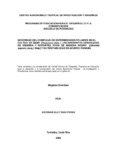| dc.contributor.advisor | Benjamín,Tamara | |
| dc.contributor.author | Ruíz Pérez, Esteban E. | |
| dc.date.accessioned | 2014-10-20T05:37:31Z | |
| dc.date.available | 2014-10-20T05:37:31Z | |
| dc.date.issued | 2003 | es_ES |
| dc.identifier | 365877 | es_ES |
| dc.identifier.uri | https://repositorio.catie.ac.cr/handle/11554/5530 | |
| dc.description | Tesis (M. Sc) -- CATIE, Turrialba (Costa Rica), 2003 | es_ES |
| dc.description | 15 ilustraciones. 8 tablas. | |
| dc.description | Referencias de las páginas 52-56 | |
| dc.description.abstract | El experimento inició en el año 2003, Finca El Ejido, Panamá. Evaluamos la incidencia de un complejo de enfermedades y la rentabilidad del cultivo del ñame utilizando tres distancia de siembra de soportes vivos (0.50, 2 y 4 m), con dos densidades de siembra de ñame (22422 y 29600 plantas ha-1) para seis tratamientos con soportes vivos, un tratamiento con soportes muertos y uno sin soportes. Se concluye que los rendimientos y rentabilidad del ñame son superiores utilizando soportes vivos que utilizando soportes muertos y sin soportes. Las condiciones dentro de los sistemas con soportes vivos parecen que están adecuadas para la Producción del ñame, pero no podemos decir como va a aportar el sistema en el futuro cuando las raíces y el follaje estén compitiendo por luz, agua y nutrientes. | es_ES |
| dc.description.abstract | Because yam yields can be reduced up to 60 percent by many different diseases, including antracnosis and bacteriosis, the incidence of disease and yam yields were evaluated in an agroforestry system using three different distances for live supports (0.5, 2, 4 m) and two densities of yam populations (22422 and 29600 plants ha-1). There were a total of six treatments with live supports an additional treatment with dead posts, one with posts and another treatment with no supports for a total of 8 treatments. Yam yields are higher when using supports and economically more beneficial when using live supports in comparison to dead or no supports. The biological conditions within a live supports system seem suitable for the dpsroduction of yam. However, it is not possible to predict how this mignt change in the future when the roots and foliage compete for light, water and nutrients. | |
| dc.format.extent | 60 páginas | |
| dc.language.iso | es | es_ES |
| dc.publisher | CATIE, Turrialba (Costa Rica) | es_ES |
| dc.subject | BACTERIOSES | |
| dc.subject | PLANT DISEASES | |
| dc.subject | MORBIDITY | |
| dc.subject | SPACING | |
| dc.subject | STAKING | |
| dc.subject | NITROGEN FIXATION | |
| dc.subject | ORGANIC MATTER | |
| dc.subject | CROP YIELDDIOSCOREA ALATA | |
| dc.subject | GLIRICIDIA SEPIUM | |
| dc.subject | GLOMERELLA CINGULATA | |
| dc.subject | BACTERIOSIS | |
| dc.subject | ENFERMEDADES DE LAS PLANTAS | |
| dc.subject | MORBOSIDAD | |
| dc.subject | ESPACIAMIENTO | |
| dc.subject | RODRIGACION | |
| dc.subject | FIJACION DEL NITROGENO | |
| dc.subject | MATERIA ORGANICA | |
| dc.subject | RENDIMIENTO DE CULTIVOS | |
| dc.subject | PANAMA | |
| dc.title | Severidad del complejo de enfermedades foliares en el cultivo de ñame (Dioscorea alata L.) en diferentes densidades de siembra y soportes vivos de madero negro (Gliricidia sepium (Jacq) Walp) y su rentabilidad en Azuero, Panamá | es_ES |
| dc.title.alternative | Severity of foliar diseases in yam (Alata dioscorea L.) grown in three densities of the effect on madero negro live supports (Gliricidia sepium (Jacq) Walp) and yam yields in Azuero, Panama | es_ES |
| dc.type | Tesis de maestría | es_ES |
| dcterms.rights | acceso abierto | es_Es |
| dc.identifier.publication | Turrialba (Costa Rica) | es_ES |


